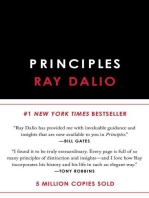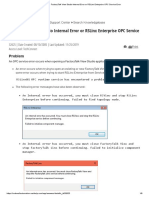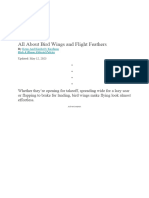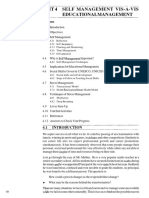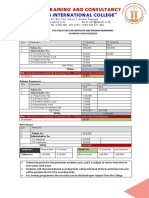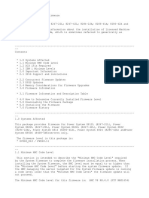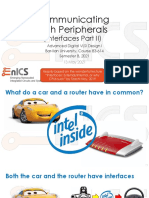0 ratings0% found this document useful (0 votes)
28 viewsOne Word To Maximum of One Sentences, Answer ALL Questions
One Word To Maximum of One Sentences, Answer ALL Questions
Uploaded by
Epics GodfreyThis document contains a model question paper for an Introduction to Computer Science course with questions in four sections - very short answer type questions, short answer questions, short essay questions, and long essay questions. The paper covers topics related to computers, operating systems, software, hardware, networks, and the internet.
Copyright:
© All Rights Reserved
Available Formats
Download as PDF, TXT or read online from Scribd
One Word To Maximum of One Sentences, Answer ALL Questions
One Word To Maximum of One Sentences, Answer ALL Questions
Uploaded by
Epics Godfrey0 ratings0% found this document useful (0 votes)
28 views18 pagesThis document contains a model question paper for an Introduction to Computer Science course with questions in four sections - very short answer type questions, short answer questions, short essay questions, and long essay questions. The paper covers topics related to computers, operating systems, software, hardware, networks, and the internet.
Original Title
ap_s1_computer_science
Copyright
© © All Rights Reserved
Available Formats
PDF, TXT or read online from Scribd
Share this document
Did you find this document useful?
Is this content inappropriate?
This document contains a model question paper for an Introduction to Computer Science course with questions in four sections - very short answer type questions, short answer questions, short essay questions, and long essay questions. The paper covers topics related to computers, operating systems, software, hardware, networks, and the internet.
Copyright:
© All Rights Reserved
Available Formats
Download as PDF, TXT or read online from Scribd
Download as pdf or txt
0 ratings0% found this document useful (0 votes)
28 views18 pagesOne Word To Maximum of One Sentences, Answer ALL Questions
One Word To Maximum of One Sentences, Answer ALL Questions
Uploaded by
Epics GodfreyThis document contains a model question paper for an Introduction to Computer Science course with questions in four sections - very short answer type questions, short answer questions, short essay questions, and long essay questions. The paper covers topics related to computers, operating systems, software, hardware, networks, and the internet.
Copyright:
© All Rights Reserved
Available Formats
Download as PDF, TXT or read online from Scribd
Download as pdf or txt
You are on page 1of 18
UNIVERSITY OF KERALA
First Degree Programme in Computer Applications
Model Question Paper
Semester I
Course Code- CP 1121
Introduction to Computer Science
TIME : 3 hrs Maximum Mark: 80
SECTION A [Very Short Answer type]
(one word to maximum of one sentences, Answer ALL questions)
10 x 1 = 10 marks
1. What is a spreadsheet?
2. What is the function of Recycle Bin?
3. Define ‘data’ with example
4. How to represent memory capacity?
5. Binary equivalent of (63)10 is
6. What is WORM?
7. Which is the hardware interface between a network and a workstation.
8. Which is the commonly used web browser.
9. What is a Compiler?
10. What is URL?
SECTION B [short answer]
[Not to exceed one paragraph, Answer any EIGHT questions.
Each question carries TWO marks]
8 x 2 – 16 marks
11. What is Booting?
12. What is an operating system?
13. What is a Modem?
14. Define ISP.
15. What do you mean by an Assembler?
16. What is called System Software?
17. What is Web Browser?
18. Define WWW.
19. What is a Word Processor?
20. Give the main difference between RAM and ROM.
21. What is MICR?
22. What is a Free Software?
SECTION C [short essay]
[Not to exceed 120 words, Answer any SIX questions.
Each question carries FOUR marks]
6 x 4=24 marks
23. Explain the term protocol. Give an example.
24. What are the types of memories available in the computer system?
25. What is system utility? Explain.
26. What is an email and how does it work?
27. What are the different types of Operating system?
28. Explain any two input devices.
29. What is difference between impact and non-impact printers?
30. Differentiate LAN, WAN and MAN.
31. What are pointing devices? Explain.
SECTION D [Long Essay]
[Answer any TWO questions. Each question carries 15 marks]
2 x 15 = 30 marks
32. Discuss the various secondary storage devices
33. Explain the application of IT in education and commerce.
34. What is meant by topology? Discuss the different topologies.
35. What are the different types of operating systems? Explain the features of any two GUI
operating systems.
UNIVERSITY OF KERALA
First Degree Programme in Computer Applications
Model Question Paper
Semester I
Course Code- CP 1132
Digital Electronics
TIME : 3 hrs Maximum Mark: 80
SECTION A [Very Short Answer type]
(one word to maximum of one sentences, Answer ALL questions)
10 x 1 = 10 marks
1. What is an IC chip?
2. What is the use of logic gates?
3. Which used as the passive component in electronic circuits?
4. What is the use of 2’s complement?
5. What are oscillators?
6. How to represent a floating point number?
7. What are Venn diagrams?
8. BCD of decimal number 67 is
9. What is an inverter?
10. What is ASCII code?
SECTION B [short answer]
[Not to exceed one paragraph, Answer any EIGHT questions.
Each question carries TWO marks]
8 x 2 – 16 marks
11. What is the difference between digital and analog system?
12. What are the various components of a digital circuit?
13. What are Flip flops?
14. Draw a half adder logic diagram.
15. What are known as basic gates?
16. What is an inductor? What is the unit of inductance?
17. Draw the circuit diagram for the expression A+B(A+C)+D
18. Define Comparator.
19. Briefly explain about the counter?
20. List three types of latches?
21. Define pulse?
22. Define gray code with suitable example.
SECTION C [short essay]
[Not to exceed 120 words, Answer any SIX questions.
Each question carries FOUR marks]
6 x 4=24 marks
23. Define edge triggered flip flop
24. Write short note of shift registers?
25. a) Convert the binary number 100111001 to hexa decimal
b) Convert the decimal number 123.345 to binary
c) Subtract 10111 from 110001
26. Develop a truth table for the standard SOP expression A’B’C+AB’C’+ABC
27. Describe the function of Full Adder Circuit
28. What is the function of a rectifier? List the different types of rectifier?
29. Explain briefly about universal gates
30. Differentiate Decoder and Encoder circuit
31. What is meant by molecular electronics?
SECTION D [Long Essay]
[Answer any TWO questions. Each question carries 15 marks]
2 x 15 = 30 marks
32. a) Explain about Multiplexer and De-multiplexer
b) State De Morgan’s theorem and apply it on the expression (A+B+C)’ + (D’E)’
33. Explain briefly about Numeric codes with suitable examples.
34. What are active and passive components? Explain in detail about the applications of
electronics?
35. Discuss the different CMOS and ECL families
UNIVERSITY OF KERALA
First Degree Programme in Computer Applications
Model Question Paper
Semester I
Course Code- CP 1141
Programming in C
TIME : 3 hrs Maximum Mark: 80
SECTION A [Very Short Answer type]
(one word to maximum of one sentences, Answer ALL questions)
10 x 1 = 10 marks
1. What are variables?
2. What is meant by associativity?
3. What is the use of ‘continue’ statement?
4. What is the use of address operator?
5. What is meant by exit controlled loop?
6. What is ‘Enum’ identifier?
7. Name the basic data types?
8. How to read a character form a file
9. What are pointers?
10. What is meant by recursion?
SECTION B [short answer]
[Not to exceed one paragraph, Answer any EIGHT questions.
Each question carries TWO marks]
8 x 2 – 16 marks
11. Why do we need to use comments in programs?
12. Explain sizeof() operator?
13. Define C tokens?
14. Write a program to reverse a number.
15. What is meant by conditional operator? With suitable examples?
16. Define implicit Type conversion?
17. What you meant by recursion?
18. What do you mean by dynamic memory allocation?
19. Explain the switch case and it syntax
20. Describe the symbols used in the flow chart
21. Write a program to reverse a number?
22. What is the need define statement in a program?
SECTION C [short essay]
[Not to exceed 120 words, Answer any SIX questions.
Each question carries FOUR marks]
6 x 4=24 marks
23. Write a short note on structure of C programs?
24. What is the difference between structure and union? Explain with example?
25. Distinguish between call by value and call by reference.
26. What is the use of malloc( )?
27. Write a program to read a list of number and store the odd numbers to the file “ODD” and
store the even numbers the file “EVEN”?
28. Write a program to find the product of two metrics?
29. Write a C program to accept a number in numerals and convert it into words
(Eg: 134 will be displayed as -> one three four)
30. What are language translators?
31. What are loops? Discuss different types
SECTION D [Long Essay]
[Answer any TWO questions. Each question carries 15 marks]
2 x 15 = 30 marks
32. Write a program to create files and store data on that file and retrieve data from that file and
print it on the screen?
33. What is the string handling functions? Explain any 4 of them with suitable example.
34. Discuss the different class of pointers in C
35. What are structures? Write a program to discuss the operations on structures?
UNIVERSITY OF KERALA
First Degree Programme in Computer Science
Model Question Paper
Semester I
Course Code- CS 1121
INTRODUCTION TO INFORMATION TECHNOLOGY
TIME : 3 hrs Maximum Mark: 80
SECTION A [Very Short Answer type]
(one word to maximum of one sentences, Answer ALL questions)
10 x 1 = 10 marks
1. What is meant by word length of a computer?
2. What is the need of secondary storage devices?
3. What are ASCII codes?
4. What are Joysticks?
5. What is multiprogramming?
6. What are registers?
7. What is meant by time sharing system?
8. What is firmware?
9. What is IP address?
10. What are search engines?
SECTION B [short answer]
[Not to exceed one paragraph, Answer any EIGHT questions.
Each question carries TWO marks]
8 x 2 = 16 marks
11. What is a workstation?
12. State two characteristics of digital signals.
13. What is a MODEM?
14. What is a binary digit?
15. What is flash memory?
16. Give differences between CD – R and CD – RW.
17. Expand the term POST
18. State features of a GUI system
19. What is LaTeX?
20. What is HTTP?
21. What is a URL?
22. Write notes on pointing devices?
SECTION C [short essay]
[Not to exceed 120 words, Answer any SIX questions.
Each question carries FOUR marks]
6 x 4=24 marks
23. Describe the Von Neumann model.
24. Classify computers according to size.
25. Differentiate between RAM and ROM.
26. Distinguish between CRT and LCD.
27. Compare Compilers and Interpreters.
28. Differentiate between a word processor and spreadsheet.
29. List the various types of internet connections.
30. Distinguish between Internet and WWW.
31. Explain the types of RAMs
SECTION D [Long Essay]
[Answer any TWO questions. Each question carries 15 marks]
2 x 15 = 30 marks
32. Give a brief history on the evolution of computers
33. Classify the various types of Operating Systems.
34. Describe the components required in building a network.
35. Discuss various output devices
UNIVERSITY OF KERALA
First Degree Programme in Computer Science
Model Question Paper
Semester I
Course Code- CS 1132
Digital Electronics & Data Communication
TIME : 3 hrs Maximum Mark: 80
SECTION A [Very Short Answer type]
(one word to maximum of one sentences, Answer ALL questions)
10 x 1 = 10 marks
1. What are Bipolar transisitors?
2. What is the need of Karnaugh map?
3. What are universal gates?
4. What are TTLs?
5. How to make 2’s complement of a number?
6. What are half-adders?
7. What are shift registers?
8. What is meant by VLSI design?
9. What is a parallel adder?
10. What is a multiplexer?
SECTION B [short answer]
[Not to exceed one paragraph, Answer any EIGHT questions.
Each question carries TWO marks]
8 x 2 – 16 marks
11. What is function of Overflow bit.
12. How to build derived gate.
13. List out the basic lows of Boolean algebra.
14. What is clocked D flip-flop?
15. What is J-K flip-flop?
16. Explain l's & 2' s compliment.
17. What are inductors?
18. What do you mean by fanout?
19. What are oscillators and where it is used?
20. What are shift registers?
21. What is a truth table, give an example.
22. What do you mean by SSI and MSI
SECTION C [short essay]
[Not to exceed 120 words, Answer any SIX questions.
Each question carries FOUR marks]
6 x 4=24 marks
23. Explain Gray code in brief?
24. Describe ASCII code in detail.
25. Convert (268.75)10 to binary, octal, hexadecimal A92H
26. What is RC Coupled Feedback Amplifiers?
27. What are the uses of Resistors and Capacitors?
28. What are the challenges of Floating point representation?
29. What do you mean by Universal Gates?
30. Write a short note in full and half adders.
31. Differentiate between minterm and maxterm
SECTION D [Long Essay]
[Answer any TWO questions. Each question carries 15 marks]
2 x 15 = 30 marks
32. What are flip flops? Explain the different types of flip flops with neat diagrams.
33. Explain the different types of multiplexers and demultiplexers and describe advantages
and disadvantages of multiplexer and demultiplexer.
34. What are Karnaugh maps. Explain the use of Karnaugh maps with suitable example.
35. Explain the concept of number system bases – binary, decimal and hexadecimal number
systems and conversion between each.
UNIVERSITY OF KERALA
First Degree Programme in Computer Science
Model Question Paper
Semester I
Course Code- CS 1141
Introduction to Programming
TIME : 3 hrs Maximum Mark: 80
SECTION A [Very Short Answer type]
(one word to maximum of one sentences, Answer ALL questions)
10 x 1 = 10 marks
1. How to define symbolic constants?
2. What are entry control loops?
3. What is the use of ‘goto’ statement?
4. What is the purpose of ‘switch’ statement?
5. What are enumerated data types?
6. What is the need of structures?
7. How to declare a pointer?
8. What is the use of storage classes?
9. What is the basic difference between Union and structure?
10. What are escape sequences?
SECTION B [short answer]
[Not to exceed one paragraph, Answer any EIGHT questions.
Each question carries TWO marks]
8 x 2 – 16 marks
11. What is the difference between two operator = and = =? Explain with example.
12. Differentiate between call by value and call by reference.
13. Write a C statement to evaluate the equation h = b2 + a2.
14. Distinguish between logical and bitwise operators.
15. What are the escape sequences?
16. Write a program to find the simple interest.
17. What is a loop? Why it is necessary in the program?
18. Mention the difference between character array and integer array
19. What is pre-processor directive?
20. How structure elements are stored in memory?
21. What is meant by dynamic memory allocation?
22. Compare between printf and fprintf function.
SECTION C [short essay]
[Not to exceed 120 words, Answer any SIX questions.
Each question carries FOUR marks]
6 x 4=24 marks
23. What is initialization? Why is it important?
24. Describe the four basic data types. Explain it with suitable example.
25. Write a program to find the sum of the squares of 10 numbers.
26. How does an append mode differs from a write mode?
27. What is a union in C? How data is stored using union?
28. Write a program to arrange a list of numbers in ascending order using function.
29. What is recursion? Explain types of recursions.
30. What is the NULL character? Why is it important?
31. Write a program to check whether the given number is Armstrong or not.
SECTION D [Long Essay]
[Answer any TWO questions. Each question carries 15 marks]
2 x 15 = 30 marks
32. Write a program to combine contents of two files in a third file. Add the line number at the
beginning of each line.
33. Write a program to add two matrices using pointers.
34. Explain various predefined macros in ctype.h
35. Discuss different control structures in C
UNIVERSITY OF KERALA
First Degree CBCSS BSc Degree Examinations
Model Question Paper
Semester I
Course Code: CS1131.2/CS1131.3
Introduction to Information Technology
TIME : 3 hrs Maximum Mark: 80
SECTION A [Very Short Answer type]
(one word to maximum of one sentences, Answer ALL questions)
10 1 = 10 marks
1. What is a nibble?
2. What makes difference between RAM and ROM
3. What is the need of registers?
4. What is the function of a plotter?
5. Expand VGA
6. What is meant by multi-tasking?
7. What is firmware?
8. What is meant by auxiliary storage?
9. What is WWW?
10. What is IP address?
SECTION B [short answer]
[Not to exceed one paragraph, Answer any EIGHT questions.
Each question carries TWO marks]
8 x 2 = 16 marks
11. What is a Workstation?
12. Compare digital and analog computers.
13. Define a Database.
14. What is a binary digit?
15. What are the essential components of a digital computer?
16. Give differences between Static and Dynamic RAM.
17. What are peripherals?
18. State the features of a GUI operating system.
19. What is LaTeX?
20. Explain about free and open source software.
21. Differentiate between a switch and a router.
22. What is a browser?
SECTION C [short essay]
[Not to exceed 120 words, Answer any SIX questions.
Each question carries FOUR marks]
6 x 4=24 marks
23. Describe the Von Neumann model.
24. Classify computers according to size.
25. What is RDRAM?
26. Distinguish between Primary and Secondary memory.
27. Explain the term booting.
28. Differentiate between a word processor and spreadsheet.
29. What are utility programs?
30. Distinguish between Internet and WWW.
31. How to protect computers from viruses?
`
SECTION D [Long Essay]
[Answer any TWO questions. Each question carries 15 marks]
2 x 15 = 30 marks
32. What are the various input devices used in a computer? Discuss.
33. Discuss the features of word processors.
34. Describe the components required in building a network
35. Explain classification of computers
UNIVERSITY OF KERALA
First Degree CBCSS BA Degree Examination November/December 2013
Model Question Paper
Semester I
Course Code- CS 1131.1
INTRODUCTION TO INFORMATION TECHNOLOGY
(for English) (2013 admission)
TIME : 3 hrs Maximum Mark: 80
SECTION A [Very Short Answer type]
(one word to maximum of one sentences, Answer ALL questions)
10 x 1 = 10 marks
1. What is meant by word length of a computer?
2. What is the need of secondary storage devices?
3. What are registers?
4. Expand ASCII?
5. What is the use of read only memory?
6. What are computer viruses?
7. What is meant by firmware?
8. What is IP address?
9. What is WWW?
10. What are plotters?
SECTION B [short answer]
[Not to exceed one paragraph, Answer any EIGHT questions.
Each question carries TWO marks]
8 x 2 = 16 marks
11. What is a workstation?
12. State two characteristics of digital signals.
13. What is a MODEM?
14. What is a binary digit?
15. What is flash memory?
16. Give differences between CD – R and CD – RW.
17. Expand the term POST
18. State features of a GUI system
19. What is LaTeX?
20. What is HTTP?
21. Name two popular E-mail software
22. What is a URL?
SECTION C [short essay]
[Not to exceed 120 words, Answer any SIX questions.
Each question carries FOUR marks]
6 x 4=24 marks
23. Describe the Von Neumann model.
24. Classify computers according to size.
25. Differentiate between RAM and ROM.
26. Distinguish between CRT and LCD.
27. Compare Compilers and Interpreters.
28. Differentiate between a word processor and spreadsheet.
29. List the various types of internet connections.
30. Distinguish between Internet and WWW.
31. Write notes on free softwares
SECTION D [Long Essay]
[Answer any TWO questions. Each question carries 15 marks]
2 x 15 = 30 marks
32. Give a brief history on the evolution of computers
33. Explain the various types of Operating Systems.
34. Describe the components required in building a network.
35. Discuss the uses of Internet
UNIVERSITY OF KERALA
First Degree CBCSS Examination in November/December 2013
Model Question Paper
Semester I
Course Code- PC 1171
FUNDAMENTALS OF COMPUTER
TIME : 3 hrs Maximum Mark: 80
SECTION A [Very Short Answer type]
(one word to maximum of one sentences, Answer ALL questions)
10 x 1 = 10 marks
1. What is ASCII?
2. Convert (01002)2 to octal.
3. What you mean by word-length of a computer?
4. Draw the truth table of OR gate
5. What is flip-flop?
6. What are microprocessors?
7. What is SDLC?
8. What is access time?
9. What is meant by track in a CD.
10. What you mean by the base of a number system?
SECTION B [short answer]
[Not to exceed one paragraph, Answer any EIGHT questions.
Each question carries TWO marks]
8 x 2 = 16 marks
11. What is cache memory?
12. Explain about assembly and machine level languages.
13. Difference between static and dynamic RAM.
14. Illustrate MOV, ADD, LDA instructions.
15. What is an interrupt.
16. What is meant by boot sector of a hard disk?
17. What is an instruction cycle?
18. What is magnetic disk?
19. What is POST?
20. What are the advantages of database over file systems.
21. Explain flash memory, with an example?
22. What are the fact finding techniques used for developing a system?
SECTION C [short essay]
[Not to exceed 120 words, Answer any SIX questions.
Each question carries FOUR marks]
6 x 4=24 marks
23. Difference between RAM and ROM
24. Explain about printers.
25. Differentiate between a half adder and a full adder?
26. Write a program to add two numbers using 8085 microprocessor instructions. Explain
27. Write down the differences between Compiler and Interpreter.
28. Explain Combinational circuit and Sequential circuit?
29. Describe DMA transfer
30. What is a real time operating system?
31. Explain the concept of virtual memory.
SECTION D [Long Essay]
[Answer any TWO questions. Each question carries 15 marks]
2 x 15 = 30 marks
32. Explain the internal architecture of 8085 microprocessor.
33. Discuss the working of J K flip-flop.
34. Explain input output devices in detail.
35. Describe functions of an operating system.
You might also like
- The Subtle Art of Not Giving a F*ck: A Counterintuitive Approach to Living a Good LifeFrom EverandThe Subtle Art of Not Giving a F*ck: A Counterintuitive Approach to Living a Good LifeRating: 4 out of 5 stars4/5 (5934)
- The Gifts of Imperfection: Let Go of Who You Think You're Supposed to Be and Embrace Who You AreFrom EverandThe Gifts of Imperfection: Let Go of Who You Think You're Supposed to Be and Embrace Who You AreRating: 4 out of 5 stars4/5 (1106)
- Never Split the Difference: Negotiating As If Your Life Depended On ItFrom EverandNever Split the Difference: Negotiating As If Your Life Depended On ItRating: 4.5 out of 5 stars4.5/5 (879)
- Grit: The Power of Passion and PerseveranceFrom EverandGrit: The Power of Passion and PerseveranceRating: 4 out of 5 stars4/5 (598)
- Hidden Figures: The American Dream and the Untold Story of the Black Women Mathematicians Who Helped Win the Space RaceFrom EverandHidden Figures: The American Dream and the Untold Story of the Black Women Mathematicians Who Helped Win the Space RaceRating: 4 out of 5 stars4/5 (925)
- Shoe Dog: A Memoir by the Creator of NikeFrom EverandShoe Dog: A Memoir by the Creator of NikeRating: 4.5 out of 5 stars4.5/5 (545)
- The Hard Thing About Hard Things: Building a Business When There Are No Easy AnswersFrom EverandThe Hard Thing About Hard Things: Building a Business When There Are No Easy AnswersRating: 4.5 out of 5 stars4.5/5 (353)
- Elon Musk: Tesla, SpaceX, and the Quest for a Fantastic FutureFrom EverandElon Musk: Tesla, SpaceX, and the Quest for a Fantastic FutureRating: 4.5 out of 5 stars4.5/5 (476)
- Her Body and Other Parties: StoriesFrom EverandHer Body and Other Parties: StoriesRating: 4 out of 5 stars4/5 (831)
- The Emperor of All Maladies: A Biography of CancerFrom EverandThe Emperor of All Maladies: A Biography of CancerRating: 4.5 out of 5 stars4.5/5 (274)
- The Little Book of Hygge: Danish Secrets to Happy LivingFrom EverandThe Little Book of Hygge: Danish Secrets to Happy LivingRating: 3.5 out of 5 stars3.5/5 (419)
- The World Is Flat 3.0: A Brief History of the Twenty-first CenturyFrom EverandThe World Is Flat 3.0: A Brief History of the Twenty-first CenturyRating: 3.5 out of 5 stars3.5/5 (2271)
- The Yellow House: A Memoir (2019 National Book Award Winner)From EverandThe Yellow House: A Memoir (2019 National Book Award Winner)Rating: 4 out of 5 stars4/5 (99)
- Devil in the Grove: Thurgood Marshall, the Groveland Boys, and the Dawn of a New AmericaFrom EverandDevil in the Grove: Thurgood Marshall, the Groveland Boys, and the Dawn of a New AmericaRating: 4.5 out of 5 stars4.5/5 (270)
- The Sympathizer: A Novel (Pulitzer Prize for Fiction)From EverandThe Sympathizer: A Novel (Pulitzer Prize for Fiction)Rating: 4.5 out of 5 stars4.5/5 (122)
- Team of Rivals: The Political Genius of Abraham LincolnFrom EverandTeam of Rivals: The Political Genius of Abraham LincolnRating: 4.5 out of 5 stars4.5/5 (235)
- A Heartbreaking Work Of Staggering Genius: A Memoir Based on a True StoryFrom EverandA Heartbreaking Work Of Staggering Genius: A Memoir Based on a True StoryRating: 3.5 out of 5 stars3.5/5 (232)
- On Fire: The (Burning) Case for a Green New DealFrom EverandOn Fire: The (Burning) Case for a Green New DealRating: 4 out of 5 stars4/5 (75)
- FactoryTalk View Studio Internal Error or RSLinx Enterprise OPC Service ErrorDocument8 pagesFactoryTalk View Studio Internal Error or RSLinx Enterprise OPC Service Errorzulfikar rochimNo ratings yet
- The Unwinding: An Inner History of the New AmericaFrom EverandThe Unwinding: An Inner History of the New AmericaRating: 4 out of 5 stars4/5 (45)
- Bell DeskDocument4 pagesBell DeskEpics GodfreyNo ratings yet
- 1.2 Hotel Core AreasDocument4 pages1.2 Hotel Core AreasEpics GodfreyNo ratings yet
- ETC2Document19 pagesETC2Epics GodfreyNo ratings yet
- Unit 4Document17 pagesUnit 4Epics GodfreyNo ratings yet
- Cst0 Computer Science Tripos Part IDocument11 pagesCst0 Computer Science Tripos Part IEpics GodfreyNo ratings yet
- Culture TourismDocument23 pagesCulture TourismEpics GodfreyNo ratings yet
- Ebook Vocational Education Tourism and Hospitality Travel Consult Class 11th 12thDocument66 pagesEbook Vocational Education Tourism and Hospitality Travel Consult Class 11th 12thEpics GodfreyNo ratings yet
- 1 Fee Structure 2022-2023 Academic YearDocument1 page1 Fee Structure 2022-2023 Academic YearEpics GodfreyNo ratings yet
- Hot Wheels Manual V3 3Document60 pagesHot Wheels Manual V3 3claudiovaldezNo ratings yet
- C Language Compiler: Psoc DesignerDocument37 pagesC Language Compiler: Psoc DesignerJoshua D JohnNo ratings yet
- Junos ErrorsDocument2 pagesJunos ErrorsrashidsharafatNo ratings yet
- Windows HBOOT Driver Installation InstructionsDocument6 pagesWindows HBOOT Driver Installation InstructionsstabongNo ratings yet
- Adapter User GuideDocument156 pagesAdapter User GuideOSCAR SIRIAS AGUILARNo ratings yet
- 220 702Document264 pages220 702Valentin Vanguelov100% (1)
- TRB Guide WLC 5520 8540Document22 pagesTRB Guide WLC 5520 8540Tiago ZacariasNo ratings yet
- 01SV860 063 056.readmeDocument14 pages01SV860 063 056.readmeme_vivek1238572No ratings yet
- Using Yocto Project With BeagleBone Black - Sample ChapterDocument25 pagesUsing Yocto Project With BeagleBone Black - Sample ChapterPackt Publishing100% (1)
- Dual Boot XP and LinuxDocument6 pagesDual Boot XP and Linuxstarwarp2000No ratings yet
- Configuring OnLine DiagnosticDocument10 pagesConfiguring OnLine Diagnosticsalist3kNo ratings yet
- Ccna2 Chapter1 Introduction To Routing and Packet ForwardingDocument131 pagesCcna2 Chapter1 Introduction To Routing and Packet Forwardingyarasql0% (1)
- Infineon SAA - XC866 DS v01 - 05 enDocument114 pagesInfineon SAA - XC866 DS v01 - 05 enpatricio andradeNo ratings yet
- Topic: 1.3.6 Operating Systems: Loading An Operating SystemDocument5 pagesTopic: 1.3.6 Operating Systems: Loading An Operating SystemAthuai DoorNo ratings yet
- English Project N1 Making A Job Application Booklet 2 AsDocument6 pagesEnglish Project N1 Making A Job Application Booklet 2 Askhkh100% (1)
- CrumProg EngDocument59 pagesCrumProg Engพ่อโกรธ พ่อต้องยิ้มNo ratings yet
- Echo 789 BrochureDocument12 pagesEcho 789 BrochureFaiz BajwaNo ratings yet
- Dell™ Vostro™ 1500 and Inspiron™ 1520/1521 Service Manual: Notes, Notices, and CautionsDocument66 pagesDell™ Vostro™ 1500 and Inspiron™ 1520/1521 Service Manual: Notes, Notices, and CautionslcbarbaNo ratings yet
- 15 Common PC Problems and How To Troubleshoot Them - HongkiatDocument18 pages15 Common PC Problems and How To Troubleshoot Them - Hongkiatያሲን ሁሴንNo ratings yet
- Lecture 5 Communicating With Peripherals 2021Document44 pagesLecture 5 Communicating With Peripherals 2021Pavan DhakeNo ratings yet
- Service Manual Pa80 PDFDocument44 pagesService Manual Pa80 PDFKolja0% (1)
- Technical Assistant Interview QuestionsDocument35 pagesTechnical Assistant Interview QuestionsVasanth MaamanNo ratings yet
- Battle of SKM and Ium: How Windows 10 Rewrites Os ArchitectureDocument65 pagesBattle of SKM and Ium: How Windows 10 Rewrites Os ArchitecturebarpbarpNo ratings yet
- RH300 RHCE Rapid Track Course Outline: Unit 1: Hardware and InstallationDocument4 pagesRH300 RHCE Rapid Track Course Outline: Unit 1: Hardware and InstallationRavindra Kumar YadavNo ratings yet
- Porting of Android On Beagle BoardDocument8 pagesPorting of Android On Beagle BoardPrabhat Kumar RaviNo ratings yet
- Ibm Infosphere Biginsights Quick Start Edition: VM Image ReadmeDocument9 pagesIbm Infosphere Biginsights Quick Start Edition: VM Image ReadmeapcsabaNo ratings yet
- 070727184637Document92 pages070727184637oiyoNo ratings yet
- PCIe Certification Guide ForDocument11 pagesPCIe Certification Guide Form3y54mNo ratings yet
- LAN-Turtle Ebook v22.03Document14 pagesLAN-Turtle Ebook v22.03jeanmaligradeNo ratings yet


